#narrative colorfield
Photo

Red films at sunset 4
Egg tempera and collage
30 x 90 cm
#Russell Boncey#Fontainebleau#France#egg tempera#tempera à l’œuf#abstract expressionism#expressionnisme abstrait#full color#narrative colorfield#Colorfield#contemporary art#colorless#art contemporain#Le Château des Tourelles#Le Plessis-Trévise#joie
4 notes
·
View notes
Photo
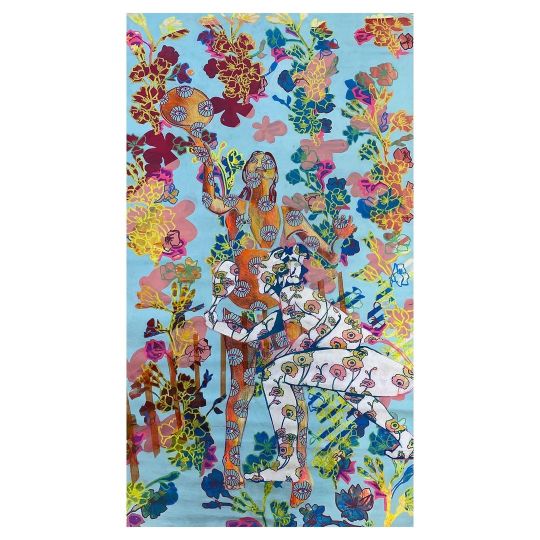
SOLD-flying to her new home for Xmas 🎄🏠 Dress to Impress, color pencils, pigments, acrylic and posca on canvas.2018 In my works you can always recognize some elements and behaviors such as layers, patterns, and color interactions. it’s my translation of balancing with real life interactions. it seems to be close to a photographic experience. as a negative, i’ll be impressed by different fields, in this case the perfume of november late flowers, noise of matkot on the beach, the change of light, and body language of people. As a woman of course, i observe people and surroundings with a familiar but procedural point of view. The narrative is an experience that is unique for each viewer, i hope as much as it is for me. each layers have interactions with each other without order or directions. you can get lost, eventually. • • • • #colorfield #colorfieldpainting #lightandspace #figurativepainting #womenartists #womenpainters #patternplay #magnoliaflower #selectedwork #colorstudy #tastewithcolour #painterly #contemporarypainter #artadvisor #saatchiart #saatchiartist #colorfulhome #buyartonline #artcollectors #telavivianmoments #telavivlife #colorsmakemehappy #abstracted #supportlivingartists #jessicamoritz #canvaspaintings #contemporaryartcollector #cheerstothat (at חוף בוגרשוב- Tel Aviv) https://www.instagram.com/p/CJJWMYBnfDG/?igshid=vt38fxjmuo7r
#colorfield#colorfieldpainting#lightandspace#figurativepainting#womenartists#womenpainters#patternplay#magnoliaflower#selectedwork#colorstudy#tastewithcolour#painterly#contemporarypainter#artadvisor#saatchiart#saatchiartist#colorfulhome#buyartonline#artcollectors#telavivianmoments#telavivlife#colorsmakemehappy#abstracted#supportlivingartists#jessicamoritz#canvaspaintings#contemporaryartcollector#cheerstothat
0 notes
Photo

Alex Weinstein | Power Lines opens this Saturday, July 27 with a reception for the artist from 2-4pm! join us! A few more words from Weinstein below: - I have been interested in the fusion of traditionally antithetical esthetic concerns for a long while now and making paintings that can function as both figurative and abstract compositions is at the core of this work. It allows me to move along experimenting with exuberant color and flirt with colorfield/minimal/light and space practices while making work grounded, at least in part, in the act of observation. The drawn power lines cinch these paintings effectively: in a narrative capacity, they force a depth of field, foreground/background read. In purely abstract terms they function strictly as sharpened foils to the soft-focus color-washes that dominate the pictures. And finally, in an allegorical capacity, they speak to the current crisis of climate change and the human mark left upon nature. -Alex Weinstein, Los Angeles,2016-19 (at Leslie Sacks Gallery) https://www.instagram.com/p/B0RiVr_lV2T/?igshid=ivs9kieesvxz
1 note
·
View note
Text
19 Precautions You Must Take Before Attending American Abstract Expressionist Artists | american abstract expressionist artists
In the aftermost three decades of the 19th century, the acreage of American ceramics blossomed. From baby potteries, which had ahead created commonsensical articles clumsy to attempt as equals with European imports, came a beginning of abstruse addition and aesthetic invention. Yet compared to the afterimage of American bowl art’s mid 20th-century greats, such as the Abstract Expressionist Peter Voulkos, or the Finish Fetish artisan Kenneth Price, the ceramics produced during the Arts and Crafts aeon is analogously obscure. In altruistic over 300 pieces of American art ceramics by 80 potters and firms to New York’s Metropolitan Museum of Art, the painter Robert A. Ellison Jr. has adapted the Met’s backing in this area.
FRANCE – SEPTEMBER 1956: Portrait of American-born painter … – american abstract expressionist artists | american abstract expressionist artists
These ceramics and commentaries on their economic, amusing and aesthetic contexts ample this volume, which is abundantly illustrated with 401 images. It is to be praised, too, for its efforts to ensure comprehension. Abstruse terms, some abstruse alike to those accustomed with ceramics – the dust-clay action or cuerda seca technique, anyone? – are explained back necessary, authoritative for across-the-board reading. The declared aim of the book is to ‘impart a abounding compassionate of American art ceramics while adulatory the bequest of a abstracted collector’. The closing ambition is appropriate, but to conflate it with the above poses article of a problem. To aggregate as a clandestine abandoned is necessarily to be fractional – a affection Ellison is accessible about, saying: ‘I […] went with my eye for abounding things.’ (This frankness, although commendable, is occasionally wince-inducing – as back he remarks, ‘I consistently acquainted that if you don’t buy it, you accept no catalyst to apprentice about it.’) The ancient allotment in the accumulating is anachronous 1876, the latest 1958, but the majority were fabricated amid 1890 and 1915; and it is in the asperous weighting of works beyond this time amount that issues arise.
We activate with the 1876 Philadelphia Centennial Exhibition, hailed actuality as ‘the aurora of American Art Pottery’. Prior to this astronomic fair, which featured an overview of apple ceramics, the US industry relied heavily on English access for both its appearance and accomplishment practices. At the exhibition, Japanese ceramics were accepted for their assortment and finishes, Danish for their classical inspiration, and French for the anew baffled barbotine technique. Barbotine – from barboter (‘to daub’) – involves adobe blooper alloyed with mineral oxides activated to ceramics with a besom in a painterly appearance to actualize impasto designs. The address accepted decidedly influential, arch anon to the development and accelerated acceptance of America’s civil version. It was with barbotine that Rookwood Ceramics came to prominence. Rookwood was the best accepted and longest actual American art pottery, founded in 1880 and continuing until able-bodied afterwards the Second Apple War. Its afterwards underglaze-painted vases featuring floral motifs over bendable gradations of colour were accepted for so continued as to be around alike today with the byword ‘art pottery’. But we additionally apprentice of efforts to attempt with automated ceramics through the added affordable, serially produced assignment of the Fulper Ceramics in New Jersey. Entering the art ceramics bazaar in 1909, Fulper’s VaseKraft band included a accepted ambit of bowl lamp designs; its bartering commonsense accustomed it to survive until 1976.
American Abstract Expressionism: Painting Action and Colorfields – american abstract expressionist artists | american abstract expressionist artists
The aboriginal self-identified ‘art pottery’ was the Chelsea Keramic Art Works of Massachusetts, founded by the Robertson ancestors in 1872. They are best notable for Hugh C. Robertson’s apparatus of berserk accepted matt glazes – ahead never accomplished by any potter in either the US or Europe – and his acknowledged archetype of the ambiguous Chinese sang-de-boeuf or oxblood glaze, the abstruse of which had been approved afterwards in the West for centuries. These bright blood-red pieces are decidedly striking, and the abundance in which they arise reveals Ellison’s accurate affection for these pieces.
Vase (c. 1897–1900), George E. Ohr. The Metropolitan Museum of Art, New York
Abstract Expressionist Painting by Jean Sampson; "Pushing … – american abstract expressionist artists | american abstract expressionist artists
Equally axiomatic is his allure with George Ohr, the self-styled ‘Mad Potter of Biloxi’. Ohr’s camp bulk of slumped, absurd and wilfully surreal pots, additional his allegorical airs – he priced his pots by their weight in gold – sets him afar from added accommodating forebears. A victim of abreast aftertaste and his own eccentricities, he was disregarded in his time (he abridged from 1880 to 1909) but is now awful collectible. In a abandonment from the accepted analysis of labour, Ohr formed alone, from advancing adobe to battlefront accomplished pieces, ambience what is now broadly advised a antecedent for 20th-century flat ceramics – decidedly the added agnostic strands that developed in the mid 1950s.
A affiliate blue-blooded ‘Clay as a Amusing Force’ discusses what were generally abstract enterprises based on William Morris’s acceptance in the adorning access of handicrafts, account about the abating backdrop of art, and accretion efforts to defended banking ability for women. The allotment on the book’s advanced awning – a matte-glazed ceramics boutonniere with a architecture of chrysanthemums produced by the Paul Revere Ceramics in Boston – is both an outstanding article and a acute achievement of amusing history. Founded by the philanthropist Helen Osborne Storrow to accommodate abutment for adolescent women, the Ceramics was run by Edith Guerrier and Edith Brown, whose affiliation was again accepted as a ‘Boston marriage’. Brown provided adept designs and accomplished the abilities of ceramics adornment to a aerial degree, as is abundantly illustrated in the acumen of this vase, busy and initialled by one Ida Goldstein.
Index of /original_pts/2015/black-american-artist – american abstract expressionist artists | american abstract expressionist artists
Vase (c. 1908–15), advised by Edith Brown and busy by Ida Goldstein, Paul Revere Pottery. The Metropolitan Museum of Art, New York
Art ceramics afterwards the Aboriginal Apple War until the backward 1950s is covered in alone the final chapter. Added than three decades of making, over a aeon of affecting social, bread-and-butter and aesthetic change, are aeroembolism together; what had been a abiding clip becomes a gallop. Given Ellison’s tastes, there are assured omissions. The ‘heavy influence’ in the United States of the Englishman Bernard Leach and the Japanese potter Shoji Hamada is bargain to two paragraphs and one almost adumbrative assignment by Antonio Prieto, while Peter Voulkos receives six pages. Neither Marguerite Wildenhain nor her adolescent émigré Ruth Duckworth are mentioned, to name but a brace of examples that could accept provided a added complete narrative. Taken on its own agreement (to accommodate a ‘full compassionate of American art pottery’), the book is at its best back accoutrement the beforehand period, the one best absolutely represented in Ellison’s donation. But as an analysis of a circuitous collection, and for animated a ablaze on the aeon afore the Aboriginal Apple War in bowl history, it makes for alluring reading.
Work & Play : Ad Reinhardt | The Bohmerian – american abstract expressionist artists | american abstract expressionist artists
American Art Pottery: The Robert A. Ellison Jr. Collection by Alice Cooney Frelinghuysen, Martin Eidelberg and Adrienne Spinozzi is appear by the Metropolitan Museum of Art.
From the December 2018 affair of Apollo. Preview and subscribe here.
American Civil War – Abstract Expressionism Painting by … – american abstract expressionist artists | american abstract expressionist artists
19 Precautions You Must Take Before Attending American Abstract Expressionist Artists | american abstract expressionist artists – american abstract expressionist artists
| Welcome to be able to our website, in this time period We’ll provide you with in relation to keyword. And from now on, this can be a very first picture:
Abstract Expressionist Painting: History, Description – american abstract expressionist artists | american abstract expressionist artists
How about impression earlier mentioned? is usually of which amazing???. if you’re more dedicated thus, I’l d teach you many impression once more underneath:
So, if you like to get all of these wonderful images regarding (19 Precautions You Must Take Before Attending American Abstract Expressionist Artists | american abstract expressionist artists), press save button to download these pictures in your computer. These are all set for download, if you’d rather and want to take it, click save symbol in the page, and it’ll be instantly downloaded to your home computer.} Finally if you need to obtain new and the recent picture related with (19 Precautions You Must Take Before Attending American Abstract Expressionist Artists | american abstract expressionist artists), please follow us on google plus or bookmark this site, we try our best to present you regular up-date with fresh and new graphics. Hope you love keeping here. For many up-dates and latest news about (19 Precautions You Must Take Before Attending American Abstract Expressionist Artists | american abstract expressionist artists) pictures, please kindly follow us on twitter, path, Instagram and google plus, or you mark this page on book mark area, We attempt to provide you with up-date periodically with fresh and new pictures, enjoy your browsing, and find the best for you.
Here you are at our website, articleabove (19 Precautions You Must Take Before Attending American Abstract Expressionist Artists | american abstract expressionist artists) published . At this time we’re delighted to announce that we have discovered an extremelyinteresting nicheto be reviewed, that is (19 Precautions You Must Take Before Attending American Abstract Expressionist Artists | american abstract expressionist artists) Most people attempting to find specifics of(19 Precautions You Must Take Before Attending American Abstract Expressionist Artists | american abstract expressionist artists) and of course one of these is you, is not it?
Moments : Helen Frankenthaler – Remembered | The Bohmerian – american abstract expressionist artists | american abstract expressionist artists
Encountering Expressionism, Part 19 – YouTube – american abstract expressionist artists | american abstract expressionist artists
trYvonne Thomas- Abstract Expressionism Art – Exposition Art Blog … – american abstract expressionist artists | american abstract expressionist artists
helen frankenthaler – american abstract expressionist artists | american abstract expressionist artists
Joe (Joseph) Stefanelli American Abstract Expressionist – Artlyst – american abstract expressionist artists | american abstract expressionist artists
40 best a r t • a n t h o n y s o r c e images on … – american abstract expressionist artists | american abstract expressionist artists
Early American Action Painters – Artlyst – american abstract expressionist artists | american abstract expressionist artists
American Abstract Expressionist Painting For Sale at 19stdibs – american abstract expressionist artists | american abstract expressionist artists
Artists of the American Abstract Expressionist Movement, Vol. 19 … – american abstract expressionist artists | american abstract expressionist artists
Abstract Expressionism | art | Britannica.com – american abstract expressionist artists | american abstract expressionist artists
New York School Press LLC: Post War American Expressionism … – american abstract expressionist artists | american abstract expressionist artists
Fritz Bultman – July, 19 – american abstract expressionist artists | american abstract expressionist artists
from WordPress https://americanartist.club/19-precautions-you-must-take-before-attending-american-abstract-expressionist-artists-american-abstract-expressionist-artists/
0 notes
Audio
A.M. Architect’s new LP ‘Color Field’.
“Color Field—the newest A.M. Architect audiovisual album—is a subversive tale about a young lady’s magnetic draw towards a cult-like pseudo-scientific research institute in rural Texas. Color Field features a narrative short film directed by A.M. Architect, as well as a unique sculptural design object (designed & produced by 79Ancestors) which plays the soundtrack via a built-in speaker, emitting colorful waves of light which can be modulated with a series of visual effects control knobs. Dubbed the Spectrasphere, its’ video content and interaction design were inspired by speculative “color therapy” instruments offered through the films’ antagonist, The Spectra Institute. The unique and limited design-object-as-album picks up where Deru and EFFIXX left off with the labels’ genesis piece, The Obverse Box (from the “1979” project).
Constructed from a solid block of intricately-milled walnut, the external design details and unique, luminous mood-enhancing visual language make Spectrasphere an artifact intended to evoke wonder and inspire those who gaze into its’ hypnotic lens.
Learn more about Color Field / Spectrasphere and watch the film:
www.79Ancestors.com/colorfield”
#Electornic Music#Ambient#Ambient Electronic#IDM#A.M. Architect#Chillwave#Dream Music#experimental electronic#Electronic Brew
0 notes
Text
“Encounter” - Final Paper
The first time I ever encountered Allison Schulnik’s work, was back in 2009 when watching the release music video for a song called “Ready, Able” by the band Grizzly Bear.
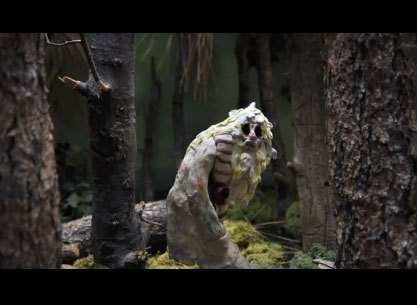
When I saw the video was in stop-motion, I was instantly taken - I have always had a love for stop-motion films. The difference with this particular film though was the way it was depicted through the mind of an Artist. It was apparent that Allison Schulnik was not just any animator or a storyteller but she was also a visualizer and thinker of otherworldly environments that inhabit creatures that could only exist in that atmosphere.
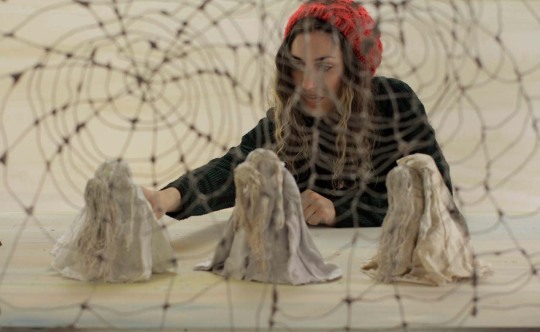
Her ability to capture the past, present, and future through sound, movement and imagery within a certain moment in time - keeps the viewer searching and wanting more of these illusive qualities. Through the mysterious characters that travel within a mystical world of an unknown time and place filled with jubilant yet stark rhythms create an experience of endless wonder. Mound, 2011, by Allison Schulnik will be discussed and dissected to explore some of these concepts through its temporality within the post-modern, remix culture and The Monster Theory by Jeffrey Jerome Cohen.

Allison Schulnik’s film, Mound, 2011, finds itself embedded into the post-modern world by its questioning of conventions through characters and perspective in terms of how we look at space and time. The opening scene reveals all characters moving synchronized to the song, It’s Raining Today by Scott Engel Walker.
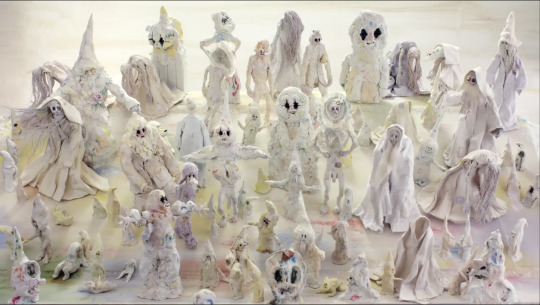
One of the first things you notice at the start of the video is the color palette. The hues are bleak and washed out yet have pastel hues of reds, yellows, blues, and greens that are scattered through out the landscape and characters. It is as both of those embodiments have become one.

Once finally getting closer and being able to see the detail of what these characters actually look like, one is immediately sunken into a pair of dark starry shaped eyes and a grinning smile. I think I am looking at a melancholy clown with red and pink cheeks and a little red nose with a white face but the colors are so muted.. it is as if the colorfulness that represent the joy of a clown have almost completely faded away from it.
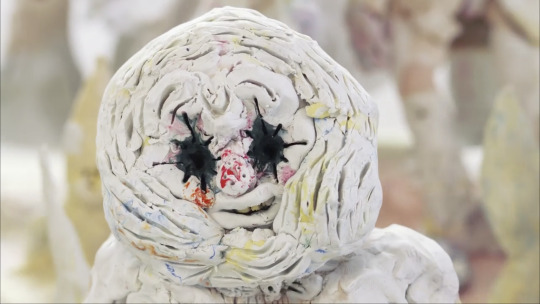
This is a depiction I am not used to seeing and as the film goes on, more and more unfamiliarity within the familiar begin to get mixed up with one another.
The concept of remix culture comes into play with Mound which lies not only within the content of the work but also of how it was made. Allison Schulnik creates all her stop-motion films the traditional way of 24 frames per second, all of the puppets and imagery are handmade from clay, fabrics, armature, wire, and paintings and all the lighting sources are specific to this process of filming.
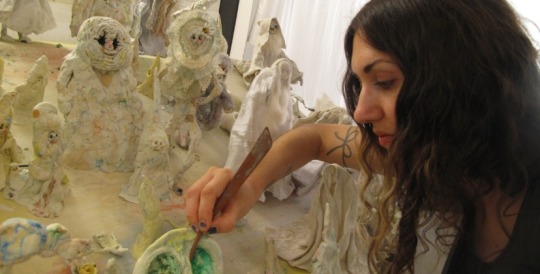
Schulnik is taking the same-old technique from the 19th century and using it now to recreate a new experience of stop-motion and its potential combined with today’s society and cultural references. For instance, the song used as the melody for the film is by Scott Engel Walker from 1969 which adds on another layer of remix onto the film. As well as within the late 60’s and early 70’s Science Fiction uprising and thus also creating “an out of the world” depiction in the film.
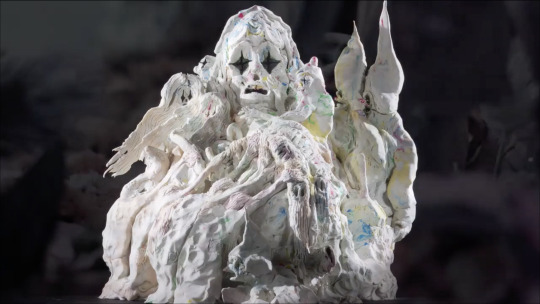
The swirling and shifting faces of the characters continuously changing according to the lyrics of the song, such as between times of 3:21-3:26 form an imagery caught between reality and illusion.


The abstraction becomes more alien through its ability to transform itself.
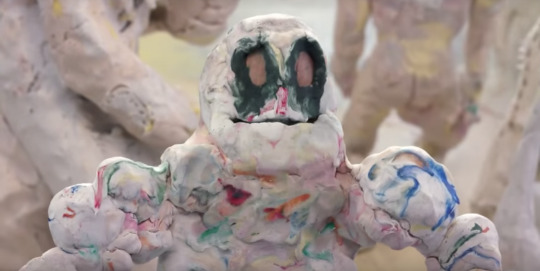
The Monster Theory by Jeffrey Jerome Cohen comes to mind while watching Mound. I believe that Allison Schulnik is signifying the unnamable described in Thesis 1. Such as representing current cultural monsters, such as the clown, which is vague through its gender and a threat by its masking identity yet she plays with this concept to morphs its appearance to become even more obscured through the process of claymation and stop-motion.
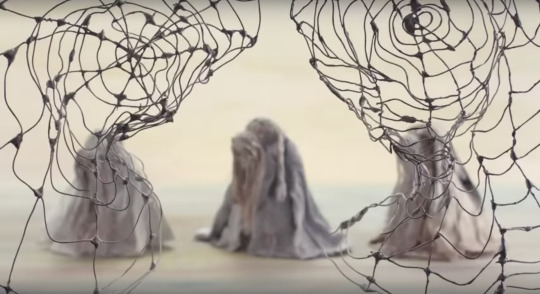
These characters dwell on the gates of difference and this is literally represented at 2:46, as weblike curtains are drawn back as wire haired dancers with their backs hunched and heads down sway with their arms and hands like a ballerina.

They begin to embody a paradox between the ugly and the beautiful, between light and darkness. That is to say that these “monsters”, characters, puppets, dancers are “at the threshold of becoming”, as Cohen would say in Thesis 7. As these characters dance in a space that no claim sense of environment but a low saturated colorfield painting as the background… we wonder where and what they are. As the dance continues with their heads down and backs hunches, the dancers still move through their lyrical forms and once they turn around with their backs to us the garments begin to bleed out water color faces that move up and down due to the dancers synchronizing their last motions to the final beats of the song.
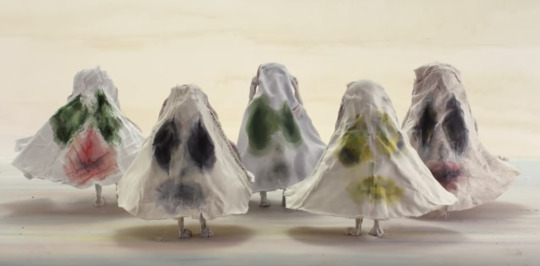
Throughout the transformative and transcending encounters of Mound,2011, I am left astonished every time upon watching the film. The way Allison Schulnik depicts emotions, physicality, movement, atmosphere, and structures is otherworldly and peculiar in beautiful way. The melding of the past, present and future are depicted throughout the works and allows the viewer to get lost within the narrative. The sound and use of an old sound created an ambiance for the film that intertwined itself with the movement of the characters and environment. The entire piece was theatrical in the sense of space, rhythm, facial and body expression, light and color. Mound, 2011, by Allison Schulnik is an artistic fieldwork that is meant for anyone who is interested in exploring concepts related to post-modern ideas, the history of remix culture and in relation to The Monster Theory by Jeffrey Jerome Cohen, as well as the subtopics within them.
0 notes
Text
Hyperallergic: A Group Show Rooted in Weeds
Ellie Irons, “Invasive Pigments Grid, New York, NY” (2016), Plexiglass, slide wells, gum arabic, plant pigments, 12″ x 12″ (all images courtesy of Goldfinch; photographs by Heather Halbert)
CHICAGO — Several didactic signs line the walls of Stella Brown’s “Rezkoville Visitor’s Center” (2017), a wooden tri-walled structure situated in the back left corner of Goldfinch’s exhibition Marginal Green. Each sign is written to inform the viewer about the plants, birds, or assorted detritus one might have found while exploring the area’s 62 acres on the Chicago River’s east bank — an overgrown post-industrial patch nicknamed for its previous owner, Antoin “Tony” Rezko, which was razed for residential and commercial development in late 2016. Like the rest of the artworks in the exhibition, this installation pays homage to the species that manage to thrive on the outskirts of American cities’ concrete plots. Works by Ellie Irons, Jenny Kendler, and Jaclyn Jacunski also attempt to reposition peripheral plants within a centralized narrative, their work focused on how the plants’ systems are entangled, both socially and environmentally, with our own.
Stella Brown, “Rezkoville Visitor’s Center” (2017), mixed media, 8′ x 8′ x 4′
Ellie Irons, “Invasive Pigments: Asiatic Dayflower (Commelina communis)” (2012), graphite and Asiatic dayflower petal pigment on paper, 20″ x 24″ (framed)
Irons, who previously spoke to Hyperallergic about her practice, demonstrates the resilience and ingenuity of these marginal species, charting invasive plants like Asiatic dayflower and pokeweed through their migration both into and out of the US. In her work “Asiatic Dayflower (Commelina communis)” (2012), she tracks the introduction of the flower to the US from China following the Columbian Exchange and observes how the plant’s evolution is specifically intertwined with human systems. A map illustrates the flower’s movement, colored with pigment extracted from the plant’s own petals. This is a technique the artist also utilizes in “Invasive Pigments Grid, New York, NY” (2016), in which colorful dot matrices fill a pair of plexiglass squares, each containing round samples of plant pigments that appear like a cross between a microscopic sampling and a watercolor swatch.
Two garden boxes, one large, the other small, lay at the center of the exhibition, attached to the front wall by thick lengths of salvaged arborists’ ropes. Jenny Kendler’s “Study for Garden for a Changing Climate” (2017) will incrementally shift toward the north end of the gallery during the course of the exhibition. Kendler’s intention is for the wheeled boxes to physically demonstrate the way global warming disrupts species’ natural growth patterns, moving from south to north. The reclaimed planters contain a lush variety of plants relocated from the gallery’s East Garfield Park neighborhood, an area that is home to many abandoned lots overgrown with grasses. Kendler glorifies the collected species as garden inhabitants rather than eyesores or nuisances, as well as imagines a futuristic landscape design in which stubborn weeds and other marginal plants are the only flora we have left.
Jenny Kendler, “Study for Garden for a Changing Climate” (2017), reclaimed wood, salvaged arborists’ rope, casters and other hardware, apoxie sculpt, enamel, organic soil, native and non-native plants from nearby lots and sidewalks
Jaclyn Jacunski also sources from the neighborhood for her works, which fill the gallery’s back room. In perhaps her most direct piece, a camera obscura softly projects the surrounding landscape onto the walls of a dark, makeshift room. Although I appreciate the attempt to recast the overgrown outside environment within, her other works present a more physical embodiment of this directive, like her aesthetically minimal, thoughtfully composed series “Colorfields” (2017), which presents six brown pieces of paper produced from native prairie plants collected from polluted plots across Chicago, dyed with inks made from the soil of the matching site. Jacunski marks the transformed plants with large swatches of original sediment, reintroducing the toxins that contaminated their roots.
Jaclyn Jacunski, “Colorfields,” installation view
Jaclyn Jacunski, “Colorfields (lot at Sacramento and Franklin),” paper made from phytoremediator, native prairie plants collected from six brownfield sites in the west side of Chicago, inks made from soil and clay pigment from the sites, 17″ x 23″
Similar plants compose her woven floor piece “Body Tracks” (2017), which lies on the opposite side of the gallery. One must walk across this braided mat to read the fine handwriting scrawled across “Margins, Borders, Lines” (2017), passages pulled from Ta-Nehisi Coates’s 2014 article “The Case for Reparations,” which, among other subjects, speaks about redlining in Chicago neighborhoods, specifically Garfield Park. The text is nearly impossible to read, even up close, but the juxtaposition of these quotes and the scattered red lines on locally sourced materials directly addresses the social nature of this specific marginalized landscape.
Like Jacunski, Brown’s installation addresses the social implications of marginalized spaces — how they are both created and, more quickly, commodified. Once home to house sparrows, chickadees, sunflowers, wild parsnip, and a section of the city’s homeless, Rezkoville is now a stripped landmass with a 15-year plan to build expensive condos and high-end retail. Cleared of its overgrowth and temporary occupants, the plot will return to its previous position as a piece of profitable urban infrastructure, demonstrating that perhaps the only thing more resilient than native plants is our need to destroy them.
Jaclyn Jacunski, “Margins, Borders, Lines” (2017), paper made from phytoremediator, native prairie plants collected from six brownfield sites in the west side of Chicago, inks made from soil and clay pigment from the sites
Jaclyn Jacunski, “Body Tracks” (2017), Phytoremediator grasses gathered from vacant lots
Marginal Green, installation view
Marginal Green continues at Goldfinch (319 N. Albany, East Garfield Park) through July 22.
The post A Group Show Rooted in Weeds appeared first on Hyperallergic.
from Hyperallergic http://ift.tt/2t4bNEX
via IFTTT
0 notes
Photo

Autumn forest abstracts 1
Series of 12
40 x 50 cm
Water-based techniques
#Russell Boncey#Fontainebleau#France#egg tempera#abstract expressionism#full color#narrative colorfield#Colorfield#contemporary art#colorless#art contemporain#tempera à l’œuf#expressionnisme abstrait#vedette#full
0 notes
Photo
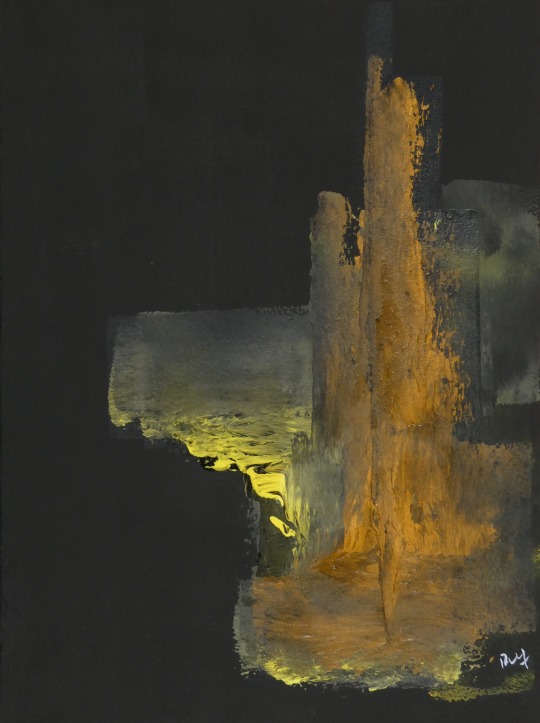
Autumn forest abstracts 1
Series of 12
40 x 50 cm
Water-based techniques
#Russell Boncey#fontainebleau#France#egg tempera#abstract expressionism#full color#narrative colorfield#Colorfield#contemporary art#colorless#art contemporain#tempera à l’œuf#expressionnisme abstrait#vedette
1 note
·
View note
Photo

Autumn forest abstracts 5
Series of 12
40 x 50 cm
Water-based techniques
#Russell boncey#Fontainebleau#France#egg tempera#tempera à l’œuf#contemporary art#art contemporain#narrative colorfield#abstract expressionism#expressionnisme abstrait#Colorfield#colorless#full color#vedette
0 notes
Photo
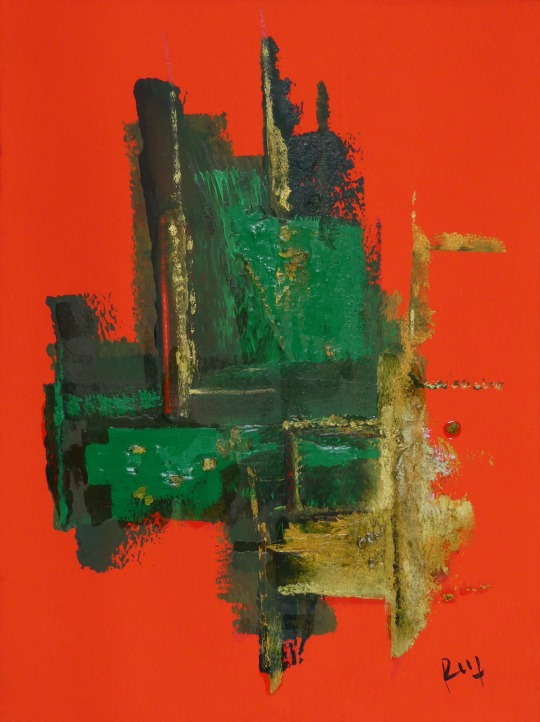
Autumn forest abstracts 5
Water based techniques
30 x 40 cm
#autumn#Russell Boncey#France#Fontainebleau#abstract expressionism#expressionnisme abstrait#contemporary art#art contemporain#egg tempera#tempera à l’œuf#colorless#Colorfield#full color#narrative colorfield#full
1 note
·
View note
Photo
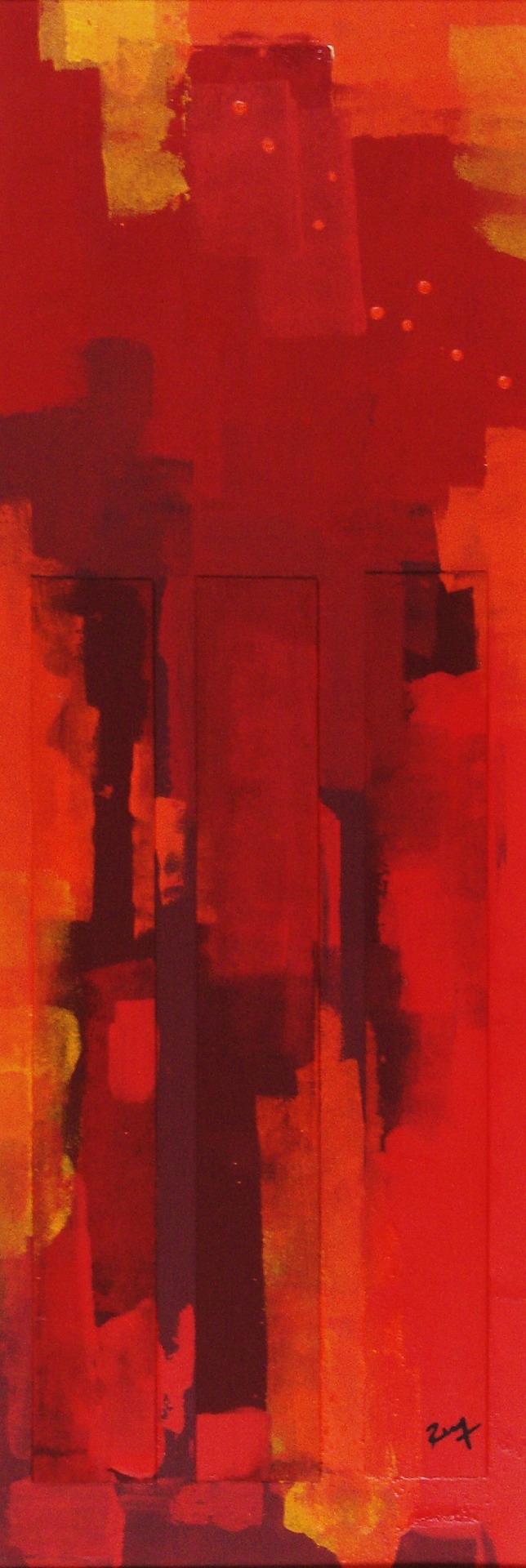
Red films at sunset 2
Egg tempera and collage
30 x 90 cm
#red#Russell Boncey#France#Fontainebleau#egg tempera#tempera à l’œuf#abstract expressionism#expressionnisme abstrait#full color#narrative colorfield#Colorfield#colorless#contemporary art#art contemporain#joie#Le Château des Tourelles#Le Plessis-Trévise
1 note
·
View note
Photo
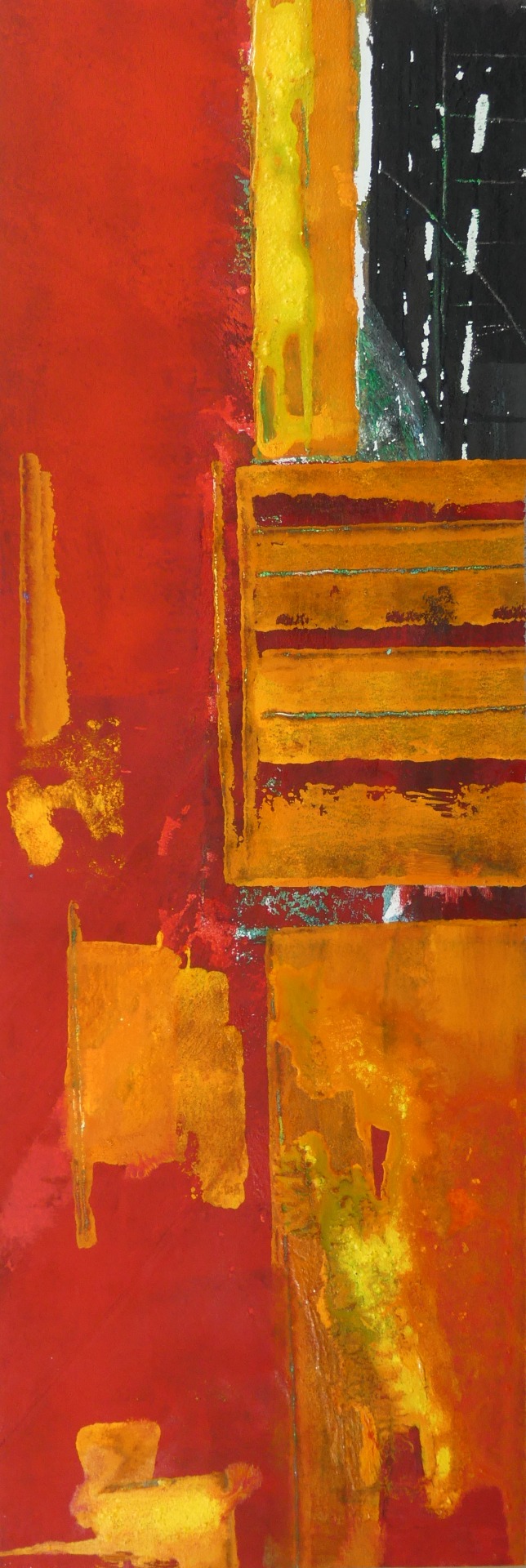
Red films at sunset 3
Egg tempera
30 x 90 cm
#Russell Boncey#Fontainebleau#France#egg tempera#tempera à l’œuf#Abstact Expressionism#expressionnisme abstrait#narrative colorfield#Colorfield#colorless#full color#contemporary art#art contemporain#red#joie#Le Château des Tourelles#Le Plessis-Trévise
0 notes
Photo

Sienne prayers 11
Egg tempera
30 x 40 cm
#russell boncey#narrative colorfield#full color#abstract expressionism#expressionnisme abstrait#egg tempera#tempera à l’œuf#Fontainebleau#France#colorfield#colorless#Sienne
1 note
·
View note
Text
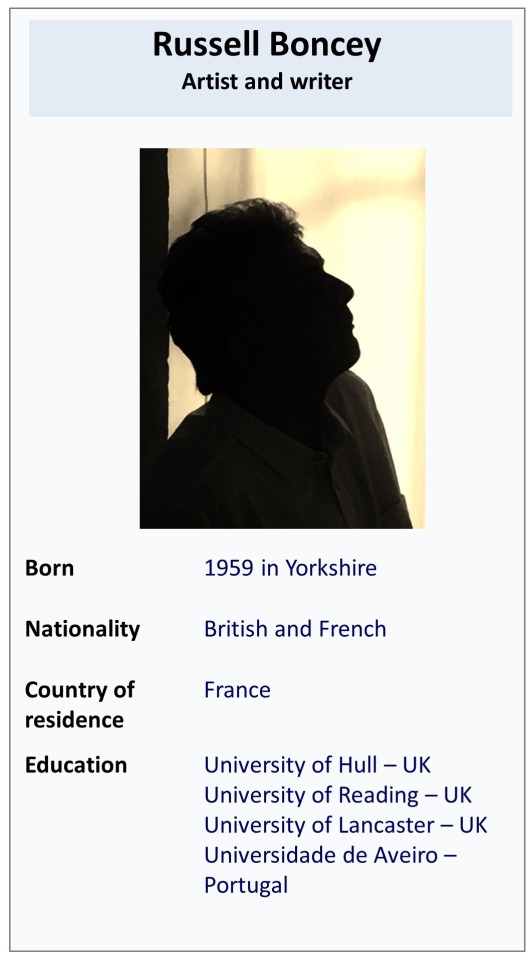
Russell Boncey
Personal details
Visit Russell Boncey’s website : https://russell-boncey.eu/
#russell boncey#france#fontainebleau#contemporary art#art contemporain#egg tempera#tempera à l’œuf#abstract expressionism#expressionnisme abstrait#narrrative colorfield#colorless#romantic narrative colorfield#full color#colorfield#expos
0 notes
Photo


The second renunciation cycle
1 Power
4 Gratification
Egg tempera on wood board - 30 x 90 cm
Visit Russell Boncey’s website : https://russell-boncey.eu/
#second#Russell Boncey#France#Fontainebleau#egg tempera#abstract expressionism#romantic narrative colorfield#narrative colorfield#Colorfield#contemporary art#colorless#art contemporain#tempera à l’œuf#expressionnisme abstrait
2 notes
·
View notes